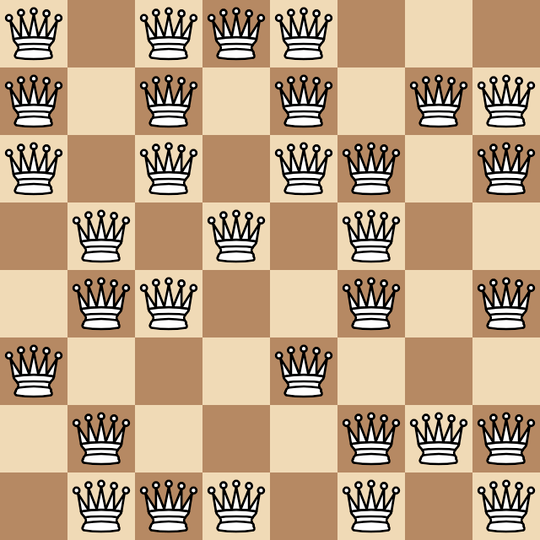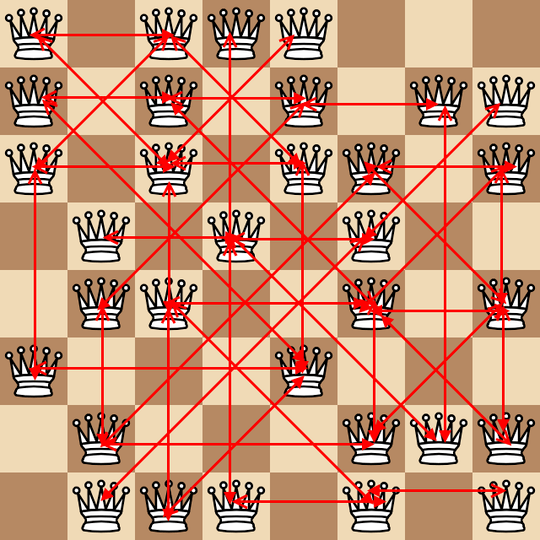26
1
Let an 8x8 chessboard be represented by any two distinct values, with one value being an empty square and the other being a queen. In the following examples, I use 0s as the empty squares and 1s as queens. For example:
is given by
1 0 1 1 1 0 0 0
1 0 1 0 1 0 1 1
1 0 1 0 1 1 0 1
0 1 0 1 0 1 0 0
0 1 1 0 0 1 0 1
1 0 0 0 1 0 0 0
0 1 0 0 0 1 1 1
0 1 1 1 0 1 0 1
Consider the number of pairs of queens that are attacking each that are at least one square away (as a reminder, queens attack orthogonally and diagonally). In the above example, the following incredible ugly diagram shows all these pairs as arrows.
There are 43 pairs found above giving the following test case:
Input:
1 0 1 1 1 0 0 0
1 0 1 0 1 0 1 1
1 0 1 0 1 1 0 1
0 1 0 1 0 1 0 0
0 1 1 0 0 1 0 1
1 0 0 0 1 0 0 0
0 1 0 0 0 1 1 1
0 1 1 1 0 1 0 1
Output: 43
Challenge
Write a program that, given a board state represented by two distinct values, outputs the number of pairs of queens that attack each other with at least one square in between them.
- You may input in whatever format is most convenient that uses two values to represent the empty squares and queens, e.g., a string of 64 "."s for empty squares and "Q"s for queens by rows from bottom to top, an 8x8 matrix of booleans, a list of list of integers 0 and 1 etc, as long as it is explained in your solution
- Output is an integer
- Standard I/O methods apply and standard loopholes forbidden
- This is code golf so shortest answer in bytes wins
Test cases:
Using the 0 and 1 format, with 0 being empty squares and 1 being queens:
Input:
0 0 0 0 0 0 0 0
0 0 0 0 0 0 0 0
0 0 0 0 0 0 0 0
0 0 0 0 0 0 0 0
0 0 0 0 0 0 0 0
0 0 0 0 0 0 0 0
0 0 0 0 0 0 0 0
0 0 0 0 0 0 0 0
Output: 0
Input:
1 1 1 1 1 1 1 1
1 1 1 1 1 1 1 1
1 1 1 1 1 1 1 1
1 1 1 1 1 1 1 1
1 1 1 1 1 1 1 1
1 1 1 1 1 1 1 1
1 1 1 1 1 1 1 1
1 1 1 1 1 1 1 1
Output: 0
Input:
0 0 0 0 0 0 0 0
0 0 0 0 0 0 0 0
0 0 0 0 0 0 0 0
0 1 0 0 0 0 1 0
0 0 0 0 0 0 0 0
0 0 0 0 0 0 0 0
0 0 0 0 0 0 0 0
0 0 0 0 0 0 0 0
Output: 1
Input:
0 0 0 0 0 0 0 0
0 0 0 1 0 0 0 0
0 0 0 0 1 0 0 0
0 1 0 0 0 0 1 0
0 0 0 0 1 0 1 0
0 0 0 0 0 0 0 0
0 0 0 1 0 0 1 0
0 0 0 0 0 0 0 0
Output: 10
Input:
1 1 1 1 1 1 1 1
1 1 1 1 1 1 1 1
1 1 1 1 1 1 1 1
1 1 1 1 1 1 1 1
1 1 1 1 0 1 1 1
1 1 1 1 1 1 1 1
1 1 1 1 1 1 1 1
1 1 1 1 1 1 1 1
Output: 4
Input:
1 1 0 1 1 1 1 1
1 1 1 1 1 1 1 1
1 1 1 1 0 1 1 1
1 1 1 1 0 1 1 1
1 1 1 1 0 1 1 1
1 1 1 1 1 1 1 1
1 1 1 1 1 1 1 1
1 1 1 1 1 1 1 1
Output: 11


I should have asked before posting my 2nd version: are 254 for a queen and 0 for an empty square acceptable input values? – Arnauld – 2018-05-06T14:15:10.493
@Arnauld You may input in whatever format is most convenient that uses two values to represent the empty squares and queens. So that's fine for sure – JMigst – 2018-05-06T15:00:05.243
Thanks. I asked because I think this rule might be a bit too permissive if taken literally. I could ask to pass a string containing most of the JS code for queens and just evaluate that in the program. (But it may be prevented by a default loophole. I'm not sure.) – Arnauld – 2018-05-06T15:09:06.387